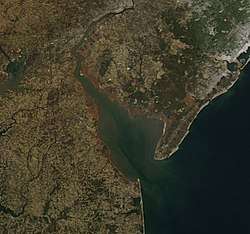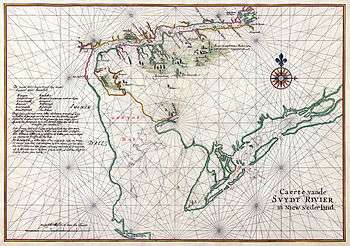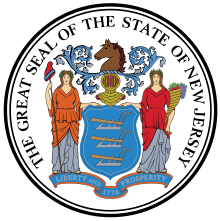Delaware Bay
Delaware Bay is the estuary outlet of the Delaware River on the northeast seaboard of the United States. Approximately 782 square miles (2,030 km2) in area,[2] the bay's fresh water mixes for many miles with the salt water of the Atlantic Ocean.
| Delaware Bay | |
|---|---|
 Delaware Bay in Winter | |
 Delaware Bay | |
| Coordinates | 39°04′N 75°10′W[1] |
| Type | Bay |
| Surface area | 782 square miles (2,030 km2)[2] |
| Surface elevation | 0 feet (0 m)[1] |
| Official name | Delaware Bay Estuary |
| Designated | 20 May 1992 |
| Reference no. | 559[3] |
The bay is bordered inland by the States of New Jersey and Delaware, and the Delaware Capes, Cape Henlopen and Cape May, on the Atlantic. The Delaware Bay is bordered by six counties: Sussex, Kent, and New Castle in Delaware, along with Cape May, Cumberland, and Salem in New Jersey. The Cape May–Lewes Ferry crosses the Delaware Bay from Cape May, New Jersey, to Lewes, Delaware. Management of ports along the bay is the responsibility of the Delaware River and Bay Authority.
The shores of the bay are largely composed of salt marshes and mudflats, with only small communities inhabiting the shore of the lower bay. Besides the Delaware, it is fed by numerous smaller rivers and streams, including (from north to south) the Christina River, Appoquinimink River, Leipsic River, Smyrna River, St. Jones River, Mispillion River, Broadkill River and Murderkill Rivers on the Delaware side, and the Salem River, Cohansey River, and Maurice Rivers on the New Jersey side. Several of the rivers hold protected status for their salt marsh wetlands bordering the bay, which serves as a breeding ground for many aquatic species, including horseshoe crabs. The bay is also a prime oystering ground.
The Delaware Bay was designated a Ramsar Wetland of International Importance on May 20, 1992. It was the first site classified in the Western Hemisphere Shorebird Reserve Network.
History
At the time of the arrival of the Europeans in the early 17th century, the area around the bay was inhabited by the Native American Lenape people. They called the Delaware River "Lenape Wihittuck", which means "the rapid stream of the Lenape". The Delaware Bay was called "Poutaxat", which means "near the falls".[4] [5]
In 1523 Lucas Vázquez de Ayllón had received from Charles V, Holy Roman Emperor a grant for the land explored in 1521 by Francisco Gordillo and slave trader Captain Pedro de Quejo (de Quexo). In 1525 Ayllón sent Quejo northward and received reports of the coastline from as far north as the Delaware Bay. In 1525 De Ayllon and Captain Quejo called Delaware Bay by the name Saint Christopher's Bay.
In the 1600s the bay was known as "Niew Port May" after Captain Cornelius May.[5]
Another recorded European visit to the bay was by Henry Hudson, who claimed it for the Dutch East India Company in 1609. The Dutch called the estuary "Godyns Bay", or "Godins Bay" after a director of the company, Samuel Godijn.[5][6] As part of the New Netherland colony, the Dutch established several settlements (the most famous being Zwaanendael) on the shores of the bay and explored its coast extensively. The thin nature of the corporate colony's presence in the bay and along what was called the South River (now the Delaware) made it possible for Peter Minuit, the former director of New Netherland, to establish a competing Swedish sponsored settlement, New Sweden in 1638. The resulting dispute with the Dutch colonial authorities in New Amsterdam (New York City) was settled when Petrus Stuyvesant led a Dutch military force into the area in 1655. After the English took title to the New Netherland colony in 1667 at the Treaty of Breda the bay came into their possession and was renamed, by Samuel Argall, the river Delaware, after the first Governor of Virginia Thomas West, 3rd Baron De La Warr.[5] The Native American tribe living along the bay and river were later called the Delaware by the Europeans due to their location. The U.S. state also takes its name from the bay and the river.

Conflicting crown grants were made to the James, Duke of York and William Penn on the west bank of the bay and river. Settlement grew rapidly, leading Philadelphia, upriver on the Delaware, to become the largest city in North America in the 18th century. Penn viewed access to the Delaware Bay as being so critical to Pennsylvania's survival that he engaged in an eighty-year long legal boundary dispute with the Calvert family to secure it. In 1782 during the American Revolutionary War, Continental Navy Lieutenant Joshua Barney fought with a British squadron within the bay. Barney's force of three sloops defeated a Royal Navy frigate, a sloop-of-war and a Loyalist privateer.
The strategic importance of the bay was noticed by the Marquis de Lafayette during the American Revolutionary War, who proposed the use of Pea Patch Island at the head of the bay for a defensive fortification to protect the important ports Philadelphia and New Castle, Delaware. Fort Delaware was later constructed on Pea Patch Island. During the American Civil War it was used as a Union prison camp.
In 1855, the United States government systematically undertook the formation of a 26 ft (7.9 m) channel 600 ft (180 m) wide from Philadelphia to deep water in Delaware Bay. The Rivers and Harbors Act of 1899 provided for a 30-foot (9.1 m) channel 600 feet (180 m) wide from Philadelphia to the deep water of the bay.
Other names for the bay have been "South Bay" and "Zuyt Baye".[5]
Today
The bay is one of the most important navigational channels in the United States; it is the second busiest waterway after the Mississippi River. Its lower course forms part of the Intracoastal Waterway. The need for direct navigation around the two capes into the ocean is circumvented by the Cape May Canal and the Lewes and Rehoboth Canal at the north and south capes respectively. The upper bay is connected directly to the north end of Chesapeake Bay by the Chesapeake and Delaware Canal.
The bay offers several challenges to mariners: a significant current of up to three knots, which quickly builds a nasty chop when the wind is in opposition; mainly shallow water, with its channel often occupied with ocean-going vessels; and relatively few places to take shelter.
See also
- Partnership for the Delaware Estuary
- Lewes and Rehoboth Canal
- Chesapeake and Delaware Canal
- Broadkill River
- St. Jones River
References
- "Delaware Bay". Geographic Names Information System. United States Geological Survey.
- Overview of the Delaware River Watershed Archived 2005-01-10 at the Wayback Machine
- "Delaware Bay Estuary". Ramsar Sites Information Service. Retrieved 25 April 2018.
- Henry Hudson claims the Delaware River for the Dutch philly.com
- Delaware Place Names United States Geological Survey
- Historic Background Delaware Department of Transportation
Further reading
- Myers, Albert Cook, ed. Narratives of Early Pennsylvania, West New Jersey, and Delaware, 1630 -1707. (New York, NY: Charles Scribner's Sons. 1912)
- Ward, Christopher. Dutch and Swedes on the Delaware, 1609 – 1664 (University of Pennsylvania Press. 1930)
- Leiby, A. C. The Early Dutch and Swedish Settlers of New Jersey (Princeton: D. Van Nostrand Co. 1964)
External links
| Wikimedia Commons has media related to Delaware Bay. |
| Wikisource has the text of the 1905 New International Encyclopedia article Delaware Bay. |

